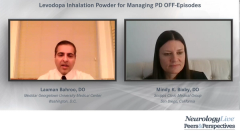
Levodopa Inhalation Powder for Managing PD OFF Episodes
Experts in Parkinson’s Disease build a discussion on the use of levodopa inhalation powder for the management of OFF time and reflect on patients’ considerations when switching therapies.
Episodes in this series

Laxman Bahroo, DO: Let’s move on to the third option, between the first and the third apomorphine option, which is the levodopa inhalation powder, also known as Inbrija. Inbrija is an inhaled levodopa only. Additionally, it does not have carbidopa in it. Dr Bixby, tell us a little about this medication.
Mindy Bixby, DO: It’s an interesting medication that has its own inhaler. Additionally, you use 2 capsules for the full dose. It’s a plastic cap, and inside is the powder you’re going to be inhaling. I teach them that it’s inhaled through this mechanism. We talk about this medication being inside a powder. It’s transmitted through the lungs, which is the mechanism of action. I wish I had 1 with me, but when you click it in, it’s like an inhaler you would normally use. You place it on your mouth, make a nice seal, and breathe in slightly and nice and comfortably. Some people may feel they need to cough. If that’s the case, I ask them to take a deep breath and have a peaceful moment so they can get the medication through. Sometimes they do cough, and that’s a normal process. If you do cough, sometimes you have a powder that comes out. It can be white or black, and that’s normal, just so you know.
From there, you do the second 1, which is the same thing. That will be the full dose. You can use that up to 5 times a day. Some people use it once. Some use it 5 times a day. Some find you can’t use it within 2 hours, so you must be thoughtful about that. The mechanism is different from the other 2 we spoke about, because 1, it is levodopa, and 2, it also is being inhaled through your lungs. It also bypasses the GI [gastrointestinal] system. Therefore, some people need a little an opportunity to have an on-episode without dealing with the gut. That’s why I like this medication for that as well. It’s been wonderful for my practice to have another option for these patients.
Laxman Bahroo, DO: I agree. It’s all about having options for our patients. As you mentioned very nicely, it is 2 capsules, and it has its own proprietary inhaler. The interesting thing is that this is a medication that individuals will prepare at the time they need it. The onset of response is 15 minutes. It bypasses the gut by going through the lungs. The time to peak on this is about 30 minutes, which was their primary end point on their study. It’s important for us to be aware that the end points are slightly different, but it the onset of full response was at 30 minutes with early onset at 10 minutes.
Of course, cough is an issue that we must talk about. Not only do we educate about OFF and when to use the medication, but also, we talk about how to use it correctly, that you must take it in. Much of our idea of using this medication comes from using the asthma inhalers we’ve seen on so many commercials and seen people using. The goal is to try to suck in the medication, and that’s what provokes the cough. As you mentioned, it’s a powder. You want to be able to take it in more gently, allowing the medication to get in. Because if you start coughing, then you’re not sure how much of the medication you’ve gotten in. The cough can be off-putting, especially with the pandemic. This is an important point.
I also tell them that if the sputum is discolored or they see discolored powder, that’s just oxidation. It’s not dirty or other issues that they might be concerned about. Additionally, many folks might be concerned about issues with lung function. Of course, lung function was measured and managed in the study. It did not show any impact, and the safety was measured up to a year. These are important points that we have to educate about when you’re using a levodopa inhalation powder. The advantages are obvious to me. When I think of it, I say, “This is a medication that does not have nausea as an adverse effect.” We’ve talked about nausea previously. The disadvantage of cough is there because the route of medication is inhalation. There are pros and cons.
Of course, there’s the preparation effect of it. Some people like the idea of carrying it and using it as needed and preparing it at that time. Other folks say, “No, I would rather not prepare anything. I just want to be able to do this as quickly as possible.” There are different options for different individuals. Have you found that patients have attempted 1 medication, switched to another, and then gone back? Or stayed with 1 or moved to a third 1?
Mindy Bixby, DO: Almost every time. Building on education and understanding, yes, some people feel like cough is nothing. Others are like, “I just can’t handle the coughing. It doesn’t make me feel comfortable, and I always know it’s gonna happen. That makes it more of a possibility that I have a cough because I know it’s gonna happen.” Others are like, “I don’t like putting something under my tongue. I can’t hold my mouth closed long enough to handle that.” So, they go on to the next 1. Sometimes, they just don’t know what they’re going to experience, so they try it. They’re in an OFF episode, especially if they’re out and about doing their thing, and they say, “What’s the most convenient for me?” Some people use several mechanisms based on when they would be OFF, which is also an interesting thought process.
Some people are using more than 1. It depends. Yes, I’ve used the idea of, “This is what you got. These are the wonderful opportunities for you.” Then we move forward and say, “What are you looking for? What’s your goal?” A lot of times, it changes when they come back. They’re like, “This is something I love, but I’m coughing all the time” or, “I can’t tolerate the nausea, so what can we do differently?” Then we’re talking about the inhaled form. Or they say, “I want it to work every single time,” so you consider if using apomorphine injectable would be more effective for them. It’s an individualized treatment plan. Always.
Laxman Bahroo, DO: It’s great to have options. The important theme is that we have options for our patients. The common theme for all these OFF episode medications is that they bypass the gut. You have subcutaneous bypassing, sublingual, and inhaled. We have options for our patients. The important thing is to query patients and have a discussion with them.
Thank you for watching this NeurologyLive® Peers & Perspectives®. If you enjoyed the content, please subscribe to the e-newsletters to receive upcoming programs and other great content in your in-box.
Transcript Edited for Clarity
Newsletter
Keep your finger on the pulse of neurology—subscribe to NeurologyLive for expert interviews, new data, and breakthrough treatment updates.













































